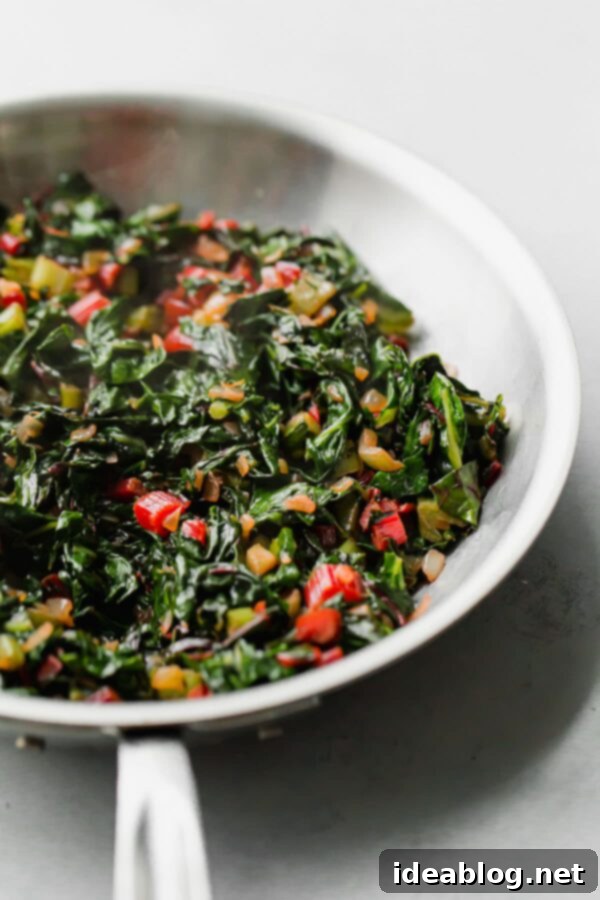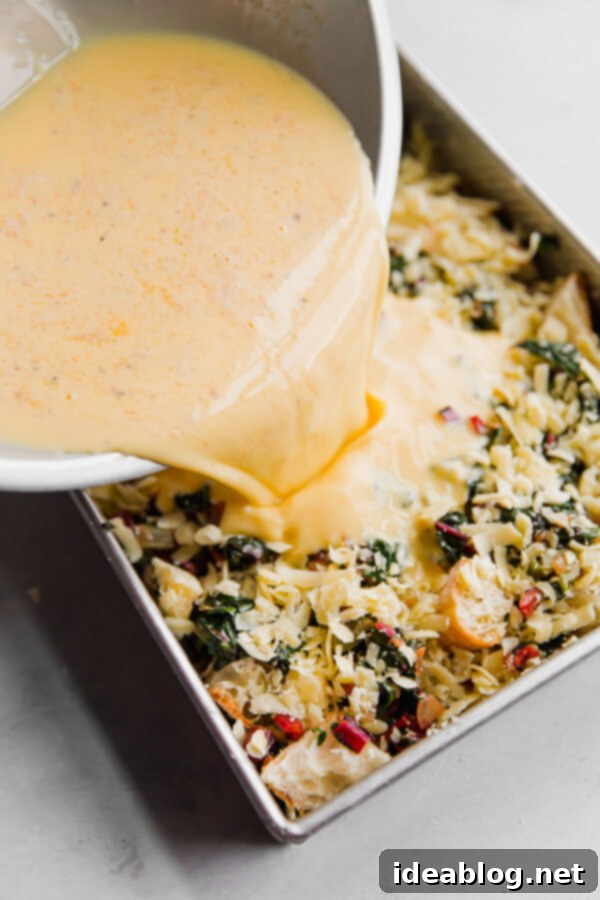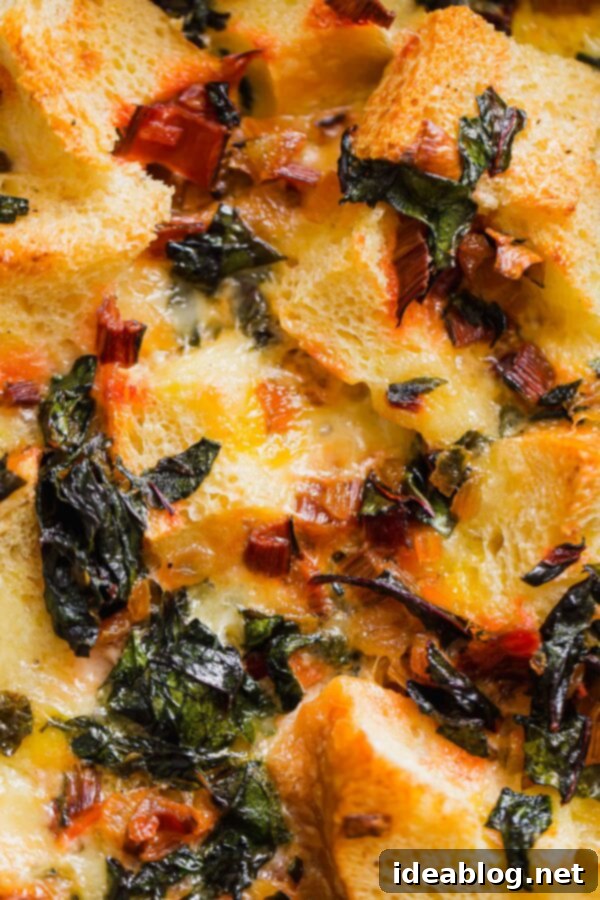Effortless Overnight Breakfast Strata: Your Go-To Vegetarian Casserole for Stress-Free Holiday Entertaining
Cheesy, pillowy, and deeply satisfying, this versatile breakfast strata is a culinary masterpiece that shines any time of year, but truly excels as the centerpiece for holiday entertaining. Imagine waking up to the aroma of a delicious, savory casserole baking, knowing that all the hard work was done the day before. This Overnight Breakfast Strata offers exactly that: a luxurious, comforting meal without the morning rush, allowing you to truly savor precious moments with family and friends.

The holiday season, with its twinkling lights and festive cheer, often brings a whirlwind of activities. Everyone has their own cherished traditions, but one universal desire is to slow down and truly embrace the spirit of togetherness. For many, this is one of the few times of year to step back, appreciate time with loved ones, and not have the entire day dictated by a rigid schedule. While I adore spending time in the kitchen, during these special winter months, my preference shifts towards limiting that time and maximizing moments spent with guests. This is precisely where this incredible Overnight Breakfast Strata becomes an absolute game-changer. It’s a dish designed for convenience, flavor, and the joy of shared meals, making your holiday mornings both delicious and effortlessly elegant.

Why This Overnight Breakfast Strata Will Become Your New Favorite
I’ve always been a proponent of make-ahead meals, especially when it comes to entertaining. The holidays, in particular, call for recipes that allow you to minimize stress and maximize enjoyment. This strata recipe is not only nearly foolproof but almost requires advance preparation, making it the ultimate host’s secret weapon. It’s the perfect answer to the common dilemma: “How do you cook eggs for a crowd?”
This vegetarian breakfast casserole has it all: a satisfying base of day-old bread, rich, flavorful cheese, and even some virtuous greens, all bound together by a luscious egg custard. The beauty of preparing it the night before means that on the morning of your gathering, all you need to do is pop it in the oven. This frees up your precious morning hours for other preparations, for enjoying a leisurely cup of coffee, or simply for relaxing with your family before the festivities begin.
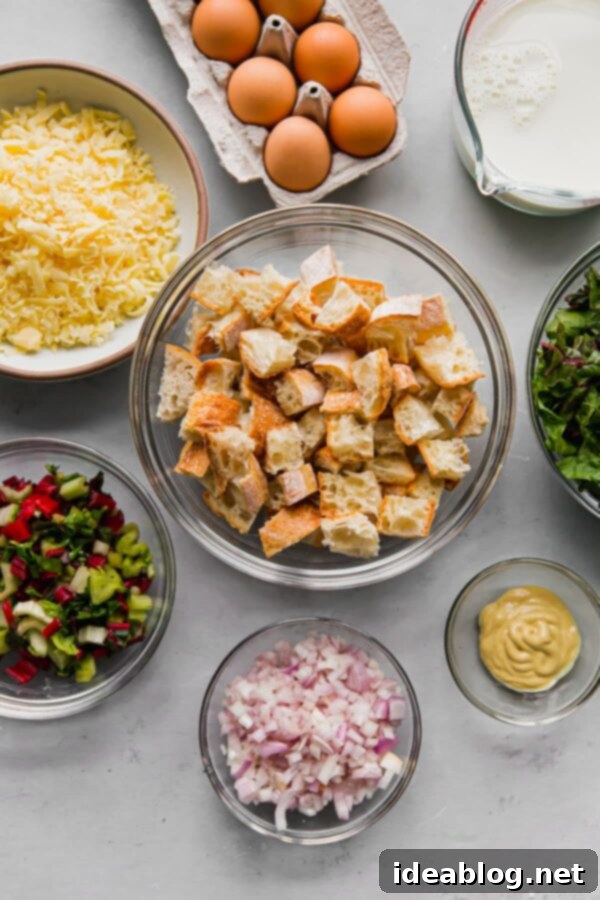
Understanding the Delight of a Strata
The word “strata” literally translates to “layered,” and in culinary terms, it refers to a savory bread pudding. It’s a casserole-style dish where layers of bread, cheese, and various fillings are soaked in an egg and milk custard, then baked until puffed, golden, and wonderfully custardy. The magic of a strata truly happens overnight.
Assembled the night prior, the dish is allowed to rest, giving the bread ample time to absorb the rich egg and milk mixture. This crucial soaking period is what transforms ordinary bread into a soft, pillowy texture that perfectly cradles the other ingredients. The flavors also meld and deepen, resulting in a more complex and satisfying taste. On the day of serving, after sitting at room temperature for about 30 minutes, it bakes for roughly an hour, or until it has risen substantially and the custard has cooked through. As it bakes, your entire house will fill with an incredibly inviting aroma, signaling that a truly special meal is on its way. Serve it up, and you’ll instantly become the brunch hero of the day!
Crafting Your Perfect Strata: A Step-by-Step Guide
The beauty of a strata lies in its forgiving nature and simple foundational ratio. Generally, strata is made with equal parts eggs, milk, and cheese, to two parts day-old bread. Adhering to this basic guideline ensures a consistently lovely, comforting, and custardy texture every time. While this recipe uses a slightly higher egg-to-milk ratio for a richer custard, rest assured, it’s quite adaptable to your preferences.
To assemble this delightful dish, begin by preparing your chosen fillings, in this case, a savory mixture of sautéed shallots and vibrant Swiss chard. Next, arrange half of your cubed day-old bread in a buttered baking dish. Layer with half of the cooked greens mixture and a generous sprinkle of freshly shredded cheese. Repeat these layers with the remaining bread, greens, and cheese, building up a delicious foundation. Finally, pour the whisked milk and egg custard evenly over the entire layered concoction. It’s crucial to ensure that all of the bread pieces are thoroughly submerged in the custard so they can properly soak up the liquid and become wonderfully soft during the overnight chill.
Once assembled, cover the baking dish tightly with foil and refrigerate for a minimum of 1 hour, or ideally, overnight. This chilling period is essential for the bread to absorb the custard and for the flavors to meld beautifully. On the day you plan to serve, remove the strata from the fridge as your oven preheats, allowing it to come closer to room temperature for about 30 minutes. Then, bake it uncovered for 55 to 65 minutes, or until it’s beautifully golden, impressively puffed, and cooked through with a set custard. The result will be a spectacular dish that looks as good as it tastes.
Swiss Chard and Cheese Strata: A Canvas for Culinary Creativity
One of the most delightful aspects of this breakfast casserole is its incredible adaptability. While today’s recipe highlights a vibrant vegetarian strata with sautéed shallots, nutrient-rich Swiss chard, and a robust shredded aged sharp cheddar or Gruyere cheese, the possibilities for customization are endless. For the chard, I make sure to use both the leaves and the stems, a simple practice that not only adds texture and flavor but also helps to reduce kitchen waste. The stems offer a pleasant crunch, while the leaves become tender and silken.
Feel free to substitute other hearty greens such as kale or spinach – just be sure to thoroughly press out any excess water from spinach after cooking to prevent a watery strata. You can also experiment with different cheeses; while sharp cheddar and Gruyere offer a wonderful depth, milder cheeses like fontina or mozzarella melt beautifully, and a sprinkle of feta or goat cheese can add a tangy counterpoint. Truly, make this recipe your own!
Consider enhancing it with other delicious additions: sautéed mushrooms bring an earthy umami, colorful bell peppers add sweetness and crunch, or blanched broccoli florets can boost the nutritional value. If you’re not strictly vegetarian, this strata is also fantastic with cooked crumbled sausage, crispy bacon bits, or diced pancetta (just be mindful of reducing the added salt if using salty cured meats). For those mornings when you need an even quicker last-minute breakfast, my Cheesy Scrambled Eggs recipe is another cherished favorite!
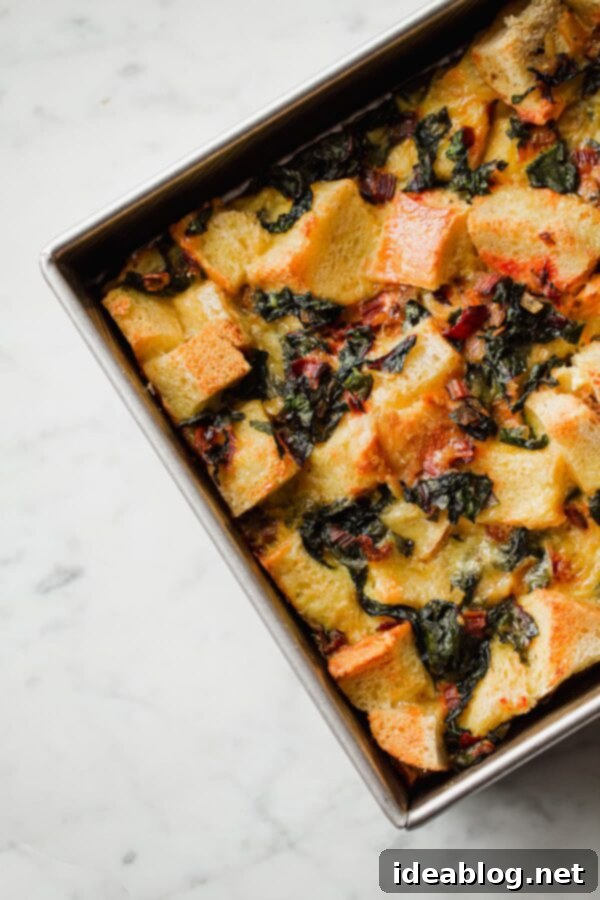
Essential Ingredients for Your Delicious Strata
Each ingredient plays a vital role in creating the perfect strata, contributing to its unique texture and rich flavor profile:
- BREAD: The foundation of any great strata. Day-old crusty French baguette is ideal because its slightly stale texture readily absorbs the custard without becoming soggy. If your bread is fresh, simply cube it and lightly toast in a 200°F (93°C) oven for about 10-15 minutes to dry it out slightly. This ensures it soaks up the egg mixture effectively. Sourdough or challah bread also work beautifully.
- SHALLOTS: These delicate members of the onion family offer a milder, sweeter, and more nuanced flavor than regular onions. When sautéed until softened, they create a savory base that enhances the overall taste of the strata without overpowering it.
- SWISS CHARD: A truly wonderful leafy green, Swiss chard is hearty and incredibly flavorful, yet it becomes wonderfully tender once cooked. You can use green, rainbow, or red chard here; the colorful red stems of rainbow chard can even add a festive touch to your holiday presentation without imparting much color to the delicate custard. Its slight bitterness beautifully balances the richness of the cheese and eggs.
- EGGS: The binding agent that holds everything together, creating the custardy texture unique to strata. This recipe calls for a dozen large eggs, offering convenience and ensuring a substantial, cohesive casserole. They provide richness and protein, making the strata a fulfilling meal.
- MILK: For the best texture and flavor, whole milk is highly recommended over low-fat alternatives. The fat content in whole milk contributes to a creamier, more luxurious custard. While I haven’t tested this specific recipe with dairy-free milks, some readers have had success with full-fat oat or almond milk, though results may vary.
- SEASONINGS: A blend of Dijon mustard, freshly grated nutmeg, kosher salt, and freshly ground black pepper are crucial for elevating the strata’s flavor. The Dijon adds a subtle tang and depth, while nutmeg brings a warm, aromatic note that complements egg dishes wonderfully. Proper seasoning ensures every bite is flavorful.
- AGED CHEDDAR: When it comes to cheddar, the sharper and more aged, the better! Its robust flavor stands up well to the other ingredients and provides a delicious, savory bite. Gruyere is another excellent choice, offering a nutty and slightly sweet profile that melts beautifully, though it can be pricier. Milder melting cheeses such as fontina or mozzarella can also be used for a softer cheese flavor and texture.

Planning Your Stress-Free Feast: An Overnight Timeline
The beauty of this strata lies in its make-ahead convenience, making your morning effortless. Here’s an example timeline to guide your preparation:
- 4:00 PM – 10:00 PM (Day Before): This window is ideal for preparing and assembling your strata. Sauté the shallots and Swiss chard, whisk the custard, layer all the ingredients in your baking dish, then pour the egg mixture over the top. Cover it tightly with foil and refrigerate it overnight. The longer it chills, the better the flavors will meld and the bread will absorb the custard.
- 7:30 AM (Day of Serving): Take the strata out of the refrigerator and let it sit at room temperature for at least 30 minutes while your oven preheats. This crucial step helps the strata bake more evenly.
- 8:00 AM: Place the uncovered strata in the preheated oven. Bake for approximately 55 to 65 minutes, or until it’s beautifully puffed, golden brown on top, and the custard is fully set. A knife inserted into the center should come out clean. Once baked, allow it to cool on a wire rack for 5 to 10 minutes before slicing.
- 9:15 AM: Slice into generous portions and serve your perfectly prepared, delicious breakfast strata!
Serving and Storing Your Delicious Strata
This recipe is designed to yield 8 generous main course servings, or up to 12 smaller portions, making it perfectly suited for a larger brunch spread or a hungry family. Its versatility means it can be served for breakfast, brunch, or even as a comforting dinner. Enjoy it hot straight out of the oven for a truly satisfying experience, or serve it at room temperature, allowing guests to graze throughout the day.
Pair this rich strata with a fresh green salad for a lighter contrast, a vibrant fruit platter for sweetness, or a side of crispy bacon or sausage for those who enjoy a heartier meal. A simple mimosa or a hot cup of coffee makes for the perfect accompaniment. Any leftover strata can be easily wrapped and stored in the refrigerator for up to 3 to 4 days. To reheat, you can use short intervals in the microwave or warm it gently in a 325°F (162°C) oven until heated through, ensuring it retains its delightful texture and flavor.

Overnight Vegetarian Breakfast Strata with Swiss Chard and Aged Cheddar
Pin
Review
SaveSaved!
Equipment
-
USA Pan 9 x 13 Inch Baking Pan
Ingredients
- 1 large bunch Swiss chard stems separated and thinly sliced, and leaves coarsely chopped
- 4 tablespoons (2 oz) unsalted butter plus extra for greasing the pan
- 2 large shallots (about 6 oz) finely chopped
- kosher salt to taste
- freshly ground black pepper to taste
- 12 large eggs
- 3½ cups (28 oz) whole milk (full-fat recommended for best texture)
- 2 tablespoons (30 g) Dijon mustard
- ½ teaspoon freshly grated nutmeg
- ½ teaspoon kosher salt
- 12 ounces day-old good-quality bread roughly 1 baguette, cut into 1-inch cubes
- 8 ounces sharp aged cheddar or Gruyere cheese freshly grated (about 2 cups)
Instructions
-
Butter a 9-inch x 13-inch baking pan generously. This helps prevent sticking and adds a delicious flavor to the crust. Set aside.
-
Prepare the Fillings (Day Before): In a 12-inch skillet, melt the butter over medium heat until it’s lightly bubbling. Add the finely chopped shallots along with a pinch of salt and sauté, stirring frequently, until they are softened and translucent, which should take about 3 to 4 minutes. Next, add the thinly sliced Swiss chard stems and continue to cook, stirring frequently, for an additional 4 to 5 minutes to allow them to tenderize. Finally, add the chopped chard greens and another pinch of salt, sautéing and flipping the greens with tongs until they are wilted and tender, about 5 minutes. Remove the skillet from the heat and season the mixture to taste with salt and freshly ground black pepper. Allow the chard and shallot mixture to cool completely to room temperature before proceeding with assembly.
-
In a large mixing bowl, whisk together the large eggs, whole milk, Dijon mustard, freshly grated nutmeg, and ½ teaspoon of kosher salt until well combined and smooth. This forms your rich custard. To assemble the strata, distribute half of the day-old bread cubes evenly in the buttered baking dish. Top this layer with half of the cooled cooked green mixture, spreading it out evenly, and then sprinkle with half of the freshly shredded cheese. Repeat this layering process with the remaining bread, greens, and cheese to create a second, equally delicious layer. Carefully pour the prepared egg custard evenly over the entire top of the layers, ensuring that all the bread cubes are fully submerged in the liquid. This ensures a moist and tender strata. Cover the baking dish tightly with foil and refrigerate overnight (or for a minimum of 1 hour if you need to bake it the same day, though overnight is highly recommended for best results).
-
Bake the Strata (Day of Serving): On the morning you plan to bake, remove the strata from the refrigerator and allow it to sit at room temperature for at least 30 minutes while your oven preheats. You will notice that the custard will have thickened considerably overnight, indicating the bread has absorbed the liquid beautifully.
-
Preheat your oven to 350°F (176°C) with an oven rack positioned in the center. Once preheated, place the uncovered strata into the oven. Bake for approximately 55 to 65 minutes, or until the strata is beautifully puffed, golden brown on top, and a knife inserted into the center comes out clean, indicating the custard is fully set. Once baked, remove it from the oven and allow the strata to cool on a wire rack for 5 to 10 minutes before slicing and serving. This resting period helps it set further and makes for cleaner slices.
-
Any delicious leftovers can be covered tightly and stored in the refrigerator for 3 to 4 days. Serve them cold, at room temperature, or reheat in short intervals in the microwave for a quick bite, or in a 325°F (162°C) oven until warmed through.
Example Timeline for Easy Planning:
- 4:00 PM – 10:00 PM (Day Before): Prep and assemble the strata, cover tightly with foil, and refrigerate overnight.
- 7:30 AM (Day of Serving): Take the strata out of the fridge and allow it to sit at room temperature for 30 minutes as the oven preheats.
- 8:00 AM: Bake uncovered for 55 to 65 minutes, or until puffy, golden, and cooked through. Cool on a rack for 5 to 10 minutes.
- 9:15 AM: Slice and serve!
Tips for Strata Success:
- Customization is Key: Don’t hesitate to personalize your strata! Feel free to experiment with different hearty greens like spinach or kale (ensure excess water is squeezed out), and a variety of cheeses such as fontina, mozzarella, or a blend.
- Add-ins: For extra flavor and texture, consider adding other cooked ingredients. Sautéed mushrooms, diced bell peppers, blanched asparagus, or even cooked sausage, bacon, or pancetta (adjusting salt accordingly) can elevate the dish.
- Day-Old Bread Advantage: Using day-old bread is crucial for proper custard absorption and a non-soggy texture. If your bread is fresh, simply cube it and lightly toast in a 200°F (93°C) oven for about 10-15 minutes to dry it out before soaking.
- Optimal Soaking: Allowing the strata to soak overnight in the refrigerator truly makes a difference in the final texture, ensuring the bread is perfectly tender and the flavors are deeply infused.
- Doneness Check: To ensure your strata is fully cooked, insert a thin knife into the center; it should come out clean. The top should be beautifully golden brown and puffed.
This recipe is inspired and adapted from Smitten Kitchen (originally adapted from Gourmet Magazine, 2003).

